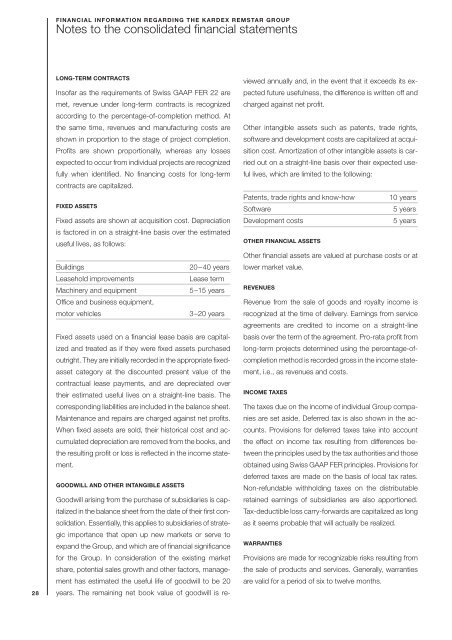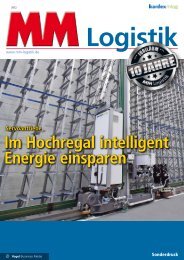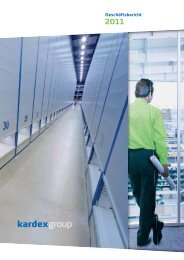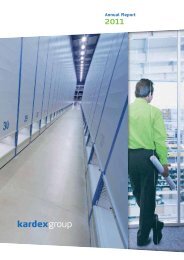You also want an ePaper? Increase the reach of your titles
YUMPU automatically turns print PDFs into web optimized ePapers that Google loves.
28<br />
FINANCIAL INFORMATION REGARDING THE KARDEX REMSTAR GROUP<br />
Notes to the consolidated financial statements<br />
LONG-TERM CONTRACTS<br />
Insofar as the requirements of Swiss GAAP FER 22 are<br />
met, revenue under long-term contracts is recognized<br />
according to the percentage-of-completion method. At<br />
the same time, revenues and manufacturing costs are<br />
shown in proportion to the stage of project completion.<br />
Profits are shown proportionally, whereas any losses<br />
expected to occur from individual projects are recognized<br />
fully when identified. No financing costs for long-term<br />
contracts are capitalized.<br />
FIXED ASSETS<br />
Fixed assets are shown at acquisition cost. Depreciation<br />
is factored in on a straight-line basis over the estimated<br />
useful lives, as follows:<br />
Buildings 20–40 years<br />
Leasehold improvements Lease term<br />
Machinery and equipment<br />
Office and business equipment,<br />
5–15 years<br />
motor vehicles 3–20 years<br />
Fixed assets used on a financial lease basis are capitalized<br />
and treated as if they were fixed assets purchased<br />
outright. They are initially recorded in the appropriate fixedasset<br />
category at the discounted present value of the<br />
contractual lease payments, and are depreciated over<br />
their estimated useful lives on a straight-line basis. The<br />
corresponding liabilities are included in the balance sheet.<br />
Maintenance and repairs are charged against net profits.<br />
When fixed assets are sold, their historical cost and accumulated<br />
depreciation are removed from the books, and<br />
the resulting profit or loss is reflected in the income statement.<br />
GOODWILL AND OTHER INTANGIBLE ASSETS<br />
Goodwill arising from the purchase of subsidiaries is capitalized<br />
in the balance sheet from the date of their first consolidation.<br />
Essentially, this applies to subsidiaries of strategic<br />
importance that open up new markets or serve to<br />
expand the Group, and which are of financial significance<br />
for the Group. In consideration of the existing market<br />
share, potential sales growth and other factors, management<br />
has estimated the useful life of goodwill to be 20<br />
years. The remaining net book value of goodwill is re-<br />
viewed annually and, in the event that it exceeds its expected<br />
future usefulness, the difference is written off and<br />
charged against net profit.<br />
Other intangible assets such as patents, trade rights,<br />
software and development costs are capitalized at acquisition<br />
cost. Amortization of other intangible assets is carried<br />
out on a straight-line basis over their expected useful<br />
lives, which are limited to the following:<br />
Patents, trade rights and know-how 10 years<br />
Software 5 years<br />
Development costs 5 years<br />
OTHER FINANCIAL ASSETS<br />
Other financial assets are valued at purchase costs or at<br />
lower market value.<br />
REVENUES<br />
Revenue from the sale of goods and royalty income is<br />
recognized at the time of delivery. Earnings from service<br />
agreements are credited to income on a straight-line<br />
basis over the term of the agreement. Pro-rata profit from<br />
long-term projects determined using the percentage-ofcompletion<br />
method is recorded gross in the income statement,<br />
i.e., as revenues and costs.<br />
INCOME TAXES<br />
The taxes due on the income of individual Group companies<br />
are set aside. Deferred tax is also shown in the accounts.<br />
Provisions for deferred taxes take into account<br />
the effect on income tax resulting from differences between<br />
the principles used by the tax authorities and those<br />
obtained using Swiss GAAP FER principles. Provisions for<br />
deferred taxes are made on the basis of local tax rates.<br />
Non-refundable withholding taxes on the distributable<br />
retained earnings of subsidiaries are also apportioned.<br />
Tax-deductible loss carry-forwards are capitalized as long<br />
as it seems probable that will actually be realized.<br />
WARRANTIES<br />
Provisions are made for recognizable risks resulting from<br />
the sale of products and services. Generally, warranties<br />
are valid for a period of six to twelve months.









